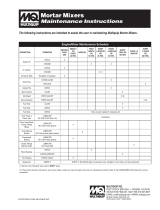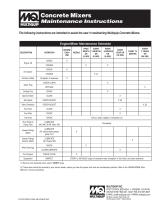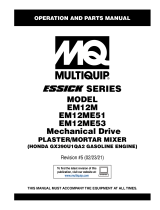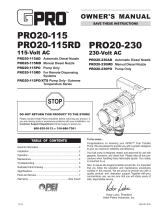
PRO20 HYDRAULIC MIXER • OPERATION MANUAL — REV. #1 (09/09/19) — PAGE 15
1. Mixing Paddles — This mixer is equipped with rubber
mixing blades for the mixing of plaster and mortar.
ALWAYS clean the paddles after each use.
2. Bag Cutter — This feature allows mixing bags to be
opened easily, allowing the contents of the bag to fall
directly into the mixing drum.
3. Hydraulic Motor — Bidirectional hydraulic motor is
used in conjunction with the directional control valve to
operate the hydraulic dump cylinder and paddle shaft.
4. Hydraulic Paddle Control Lever — Push this
three-position lever inward for clockwise rotation of
the paddle blades. Place in the center position for no
rotation (neutral/off).
5. Hydraulic Dump Lever — Push this lever inward to
activate the dump cylinders.
6. Latch — Use this latch to secure the engine
compartment enclosure.
7. Hydraulic Pump — Supplies hydraulic fluid to the
hydraulic control valve.
8. Hydraulic Oil Sight Gauge — This gauge indicates
the level and temperature of the hydraulic oil. For
normal operation, the oil level should be visible at the
midpoint on the sight gauge.
9. Adjustable Stabilizer Jack Stands — Use these jack
stands to adjust the mixer to the desired height.
10. Mixing Drum — Drum capacity is 20 cubic feet
(566 liters). Mixing materials such as mortar and plaster
are placed into this drum for mixing. ALWAYS clean
the drum after each use.
11. Shaft Seals — There is a Zerk grease fitting at each
end of the mixing drum. These grease fittings lubricate
the paddle shaft seals. Fittings require daily greasing
with lithium-based EP grease.
12. Drum Bearing — There is a pillow block bearing on
each end of the mixing drum. Bearings require daily
greasing with lithium-based EP grease.
13. Hydraulic Dump Cylinder — When activated, these
cylinders will cause the mixing drum to rotate to the
dump position.
14. Pivot Point/Zerk Fitting — There is a Zerk grease
fitting on each end of the mixing drum. These fittings
lubricate the dumping mechanism. Lubricate both
fittings at least twice a week.
15. Emergency Stop Switch — This switch is located
on the side of the engine cover. When activated, it will
shut down the engine.
16. Safety Grill — Provided for operator safety. This safety
grill is designed to keep hands and solid objects out
of the mixing drum when in use. This grill should be
closed at all times while the mixer is in use. DO NOT
remove the grill or grill opening bar. Keep the grill clean
by washing it down daily.
17. Forklift Pockets — When lifting of the mixer is
required, use these forklift pockets to lift the mixer.
Remember to insert the forks of the forklift a minimum
of 24 inches into the forklift pockets.
18. Hydraulic Oil Filter — 10-micron hydraulic filter. Filters
out small particles that are harmful to the hydraulic
system.
19. Hydraulic Valve — Directional hydraulic control valve.
Controls the direction of hydraulic fluid supplied to the
dump cylinder and paddle shaft.
20. Swivel Jack Stands — These jack stands swivel out
to support the mixer.
21. Engine Cover — Lift this cover to gain access to the
engine.
COMPONENTS (MIXER)

































